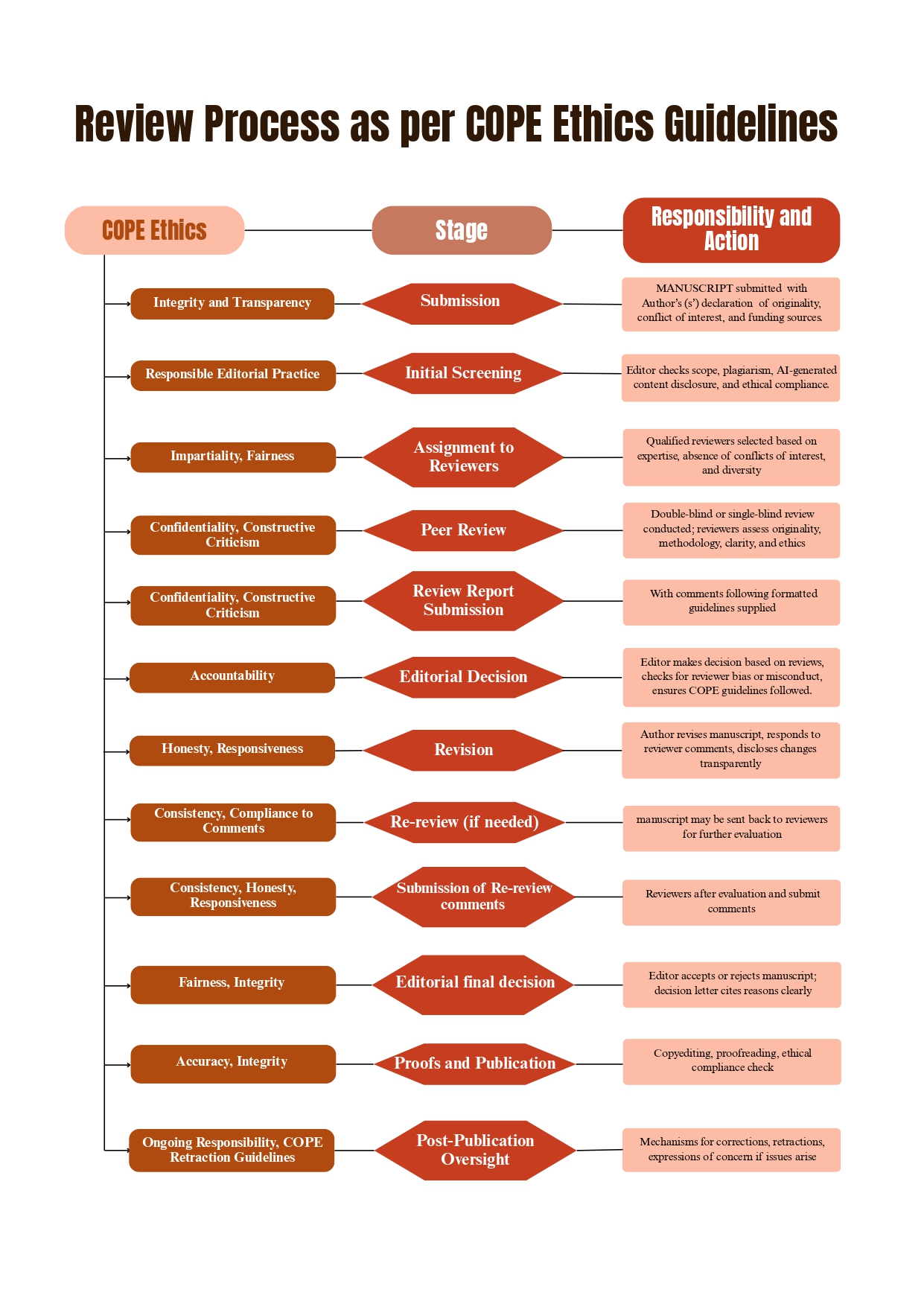The review process, fundamental to a quality publication, has four axes – administration, editors of the journal, external reviewers and the author(s). This process in Sampratyaya recognizes coordinated contribution of these axes to ensure quality of articles. The administration keeps records of the articles submitted by authors and makes correspondence with them when required. The process of review involves several steps. The first step involves receiving and recording articles, deciding on the eligibility of an article for peer review. The designated co-editor screens the article on the basis of (i) the declaration submitted by the author(s) along with the manuscripts, (ii) initial screening about the quality of article and its nature of contribution to academics, and (iii) its conformity with author’s guidelines, and the aims and scope of the journal. He or she decides whether to accept or reject the article. Rejection is intimated to the author by the administration. Acceptance leads to peer review. The second step involves the double-blind peer review. The reviewers point out the areas of strength and weakness of the article with their observations, comments and suggestions, and make recommendations for acceptance or rejection. The third step involves revision/improvement of the article by the author(s) on the basis of observations, suggestions and comments of reviewers. The fourth step involves second time scrutiny in which the co-editors or other designated editors ensure whether the revision conforms to observations, suggestions and comments of reviewers or not. The fifth step involves selection of the article for a particular number and issue of the journal by the Chief Editor/ Academic Coordinator of ASSRA (Ananta-Satyabhama Society for Research & Action). However, final decision of accepting or rejecting an article solely depends on the Chief Editor/Academic Coordinator.
The steps followed in the review process are presented in the flow chart in the next page for clarity.
Time limit for each stage is flexible; but normally the editors work to complete the entire process of review within five months, including revision and re-submission.
Ethical guidelines available from the Committee on Publication Ethics (COPE) are strictly adhered to in reviewing process.
Reviewers are provided with guidelines consisting of closed-end and open-end questions.
Peer review and reviewers:
Peer reviewers belong to all the disciplines. Chief Editor/Academic Coordinator confidentially maintains a list of experts from his/her personal contact and from contact network of members of editorial committee. Besides, experts from different educational institutions/universities are searched and contacted by co-editors. Different search tools and databases are used to find reviewers working on similar topics. Members of Editorial Advisory Committee can be a great source of reviewers, by reviewing themselves or suggesting from their network. The reviewers who may decline to review shall be requested to suggest alternative names.
 Members of editorial/editorial advisory committee may submit articles for possible publication in the journal. In such cases the peer review process will be handled by alternative members of the editorial committee and the submitting member will have no involvement in the process.
Members of editorial/editorial advisory committee may submit articles for possible publication in the journal. In such cases the peer review process will be handled by alternative members of the editorial committee and the submitting member will have no involvement in the process.
Reward
Presently, reviewers will receive complement copy of the journal and subsequently, along with current issue, the old issues. The work of the reviewers will be recognized and validated.
Note for Reviewer
The reviewers are at their liberty to review the paper/article. However, for uniformity a few hints are suggested though they may not be applicable to all types of articles. The hints are general and specific.
- General
Review shall be ideology-neutral. The purpose shall be to instil research sense in young scholars where it is necessary. Reviewers are requested to suggest for improvement.
- Specific
Strength and weakness of the article shall be examined with reference to originality, relevance of approach/methods, consistency, over all structure and organisation of content, logic of argument etc.
In view of this, the following format needs to be filled in.
- Does the title of the article suggest a topic of contemporary academic relevance and up-to-date? Yes/No
- Are objectives, hypothesis/research questions and methodology clearly and adequately formulated to cover the content and argument? Yes/No
- Is the title consistent with the objectives/hypotheses, content and arguments presented in the paper? Yes/No
(Please suggest in comments box)
- Is the conclusion consistent with objectives/hypotheses and findings/analysis? Yes/No
(Please suggest the weakness in comments space)
- Is the language of the article clear, concise and appropriate? Yes/No
- Will the language hold interest of the readers for whom the article is intended? Yes/No
- Does the article require language editing? Yes/No
(Please suggest in comments space)
- Is the organisation of presentation systematic, consistent and logical? Yes/No
- Is review of literature sufficient to justify the present study? Yes/No
- Is there any notable overlapping or discontinuity within the article?Yes/No
- Is there anything which has to be deleted or toned down? Yes/No
- Does the paper contribute to existing literature in the field or point to an innovative area or holds policy implication? Please mention———
- Is the article sufficiently original? Yes/No
- Is there any indication of violation of academic integrity and ethics? Yes/No
- Is there any obvious superficiality in argument or materials used which may be legally defamatory or controversial or sensitive? Yes/No
- Are the illustrations and tables functionally and technically relevant in the article? Yes/No
Observation, Comments and Suggestions
A. To author (s)
B. To Editor
Recommendation
- Recommended in its present form
- Recommended with major revisions
- Recommended with minor revisions
- Rejected